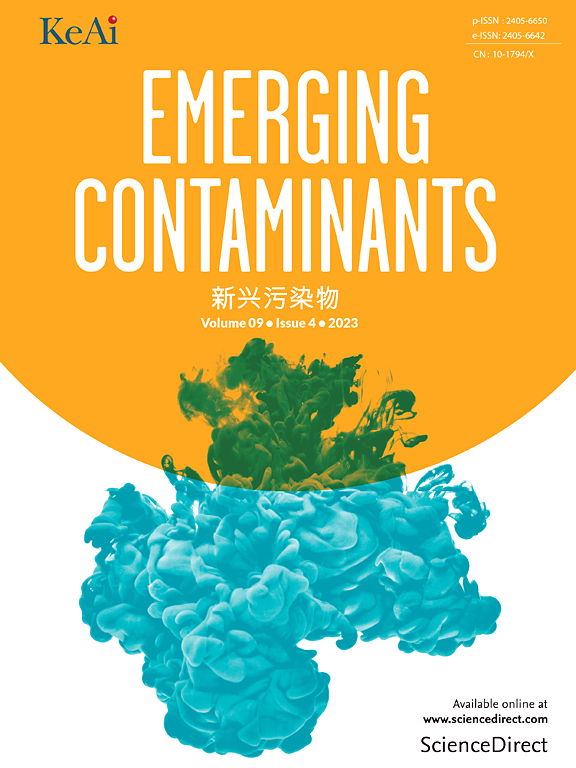有机磷农药和聚酰胺微塑料对斑纹鲶鱼幼鱼生长、血液学和免疫反应的联合影响
IF 6.9
2区 环境科学与生态学
Q1 ENVIRONMENTAL SCIENCES
引用次数: 0
摘要
有机磷农药和微塑料是淡水生态系统的两大威胁。单独来看,它们对水生动物的影响已经确定,但它们的综合影响仍然知之甚少。然而,在人类世,多种污染物同时影响水生生物,它们的综合影响可能不是相加的。因此,研究多种应激源对水生动物的交互作用具有重要意义。本研究研究了亚致死浓度杀虫剂杀虫磷(0.60 mg/L)和聚酰胺微塑料(10 mg/L)对斑纹鲶鱼幼鱼28 d内存活、生长、血液学和免疫基因表达的影响。鱼分别暴露于微塑料(MP)、氟硫磷(Fen)、两种压力源组合(Fen + MP)或两者都不暴露(对照组)。共同暴露于氟代磷和微塑料(Fen + MP)会导致微塑料积累增加,生长性能降低(增重、特定生长率和饲料效率),存活率降低,以及显著的血液学变化,包括血糖升高(143.89 mg/dL)和血红蛋白降低(7.30 g/dL)。细胞和细胞核异常,如微核和泪滴状细胞,在Fen + MP治疗中最为明显。组织病理分析显示,在共暴露下,鳃、肝、肾和肠组织严重损伤。在免疫学上,Fen + MP上调白细胞介素-1β (IL-1β)表达,下调主要组织相容性复合体- ii (MHC-II)和干扰素基因(IFN-α2, IFN-β2)。这些发现强调,所选农药和微塑料的联合暴露会加剧条纹鲶鱼的生理、细胞和免疫损伤,对它们的健康和生存构成重大风险。本文章由计算机程序翻译,如有差异,请以英文原文为准。
Combined impacts of organophosphate pesticide and polyamide microplastics on growth, hematology, and immune responses in juvenile striped catfish (Pangasianodon hypophthalmus)
Organophosphate pesticides and microplastics are two major threats to freshwater ecosystems. Individually, their impacts on aquatic animals are well established, but their combined effects remain poorly understood. Yet, in the Anthropocene, multiple pollutants simultaneously affect aquatic organisms, and their combined effects may not be additive. It is therefore important to study the interactive effects of multiple stressors on aquatic animals. This study examined the effects of sub-lethal concentrations of the pesticide fenitrothion (0.60 mg/L) and polyamide microplastics (10 mg/L) on survival, growth, hematology, and immune-gene expression in juvenile striped catfish (Pangasianodon hypophthalmus) over 28 days. Fish were exposed to microplastics (MP), fenitrothion (Fen), both stressors combined (Fen + MP), or neither (control). Co-exposure to fenitrothion and microplastics (Fen + MP) led to increased microplastic accumulation, reduced growth performance (weight gain, specific growth rate, and feed efficiency), lower survival rates, and significant hematological changes, including elevated glucose (143.89 mg/dL) and reduced hemoglobin (7.30 g/dL). Cellular and nuclear abnormalities, such as micronuclei and teardrop-shaped cells, were most pronounced in Fen + MP treatments. Histo-pathological analysis revealed severe tissue damage in gills, liver, kidney, and intestines under co-exposure. Immunologically, Fen + MP upregulated interleukin-1β (IL-1β) expression but downregulated major histocompatibility complex-II (MHC-II) and interferon genes (IFN-α2, IFN-β2). These findings highlight that combined exposure to the chosen pesticides and microplastics exacerbates physiological, cellular, and immune impairments in striped catfish, posing significant risks to their health and survival.
求助全文
通过发布文献求助,成功后即可免费获取论文全文。
去求助
来源期刊

Emerging Contaminants
Medicine-Public Health, Environmental and Occupational Health
CiteScore
10.00
自引率
6.70%
发文量
35
审稿时长
44 days
期刊介绍:
Emerging Contaminants is an outlet for world-leading research addressing problems associated with environmental contamination caused by emerging contaminants and their solutions. Emerging contaminants are defined as chemicals that are not currently (or have been only recently) regulated and about which there exist concerns regarding their impact on human or ecological health. Examples of emerging contaminants include disinfection by-products, pharmaceutical and personal care products, persistent organic chemicals, and mercury etc. as well as their degradation products. We encourage papers addressing science that facilitates greater understanding of the nature, extent, and impacts of the presence of emerging contaminants in the environment; technology that exploits original principles to reduce and control their environmental presence; as well as the development, implementation and efficacy of national and international policies to protect human health and the environment from emerging contaminants.
 求助内容:
求助内容: 应助结果提醒方式:
应助结果提醒方式:


